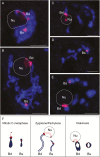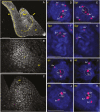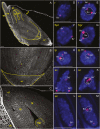Ribosomal DNA loci derived from Brachypodium stacei are switched off for major parts of the life cycle of Brachypodium hybridum
- PMID: 30481334
- PMCID: PMC6363085
- DOI: 10.1093/jxb/ery425
Ribosomal DNA loci derived from Brachypodium stacei are switched off for major parts of the life cycle of Brachypodium hybridum
Abstract
Nucleolar dominance is an epigenetic phenomenon that occurs in some plant and animal allopolyploids and hybrids, whereby only one ancestral set of 35S rRNA genes retains the ability to form the nucleolus while the rDNA loci derived from the other progenitor are transcriptionally silenced. There is substantial evidence that nucleolar dominance is regulated developmentally. This study focuses upon the establishment and/or maintenance of nucleolar dominance during different stages of development in the model grass allotetraploid Brachypodium hybridum. Fluorescence in situ hybridization with a 25S rDNA probe to cells in three-dimensional cytogenetic preparations showed that nucleolar dominance is present not only in root meristematic and differentiated cells of this species, but also in male meiocytes at prophase I, tetrads of microspores, and different embryonic tissues. The inactive state of Brachypodium stacei-originated rDNA loci was confirmed by silver staining. Only B. distachyon-derived 35S rDNA loci formed nucleoli in the aforementioned tissues, whereas B. stacei-like loci remained highly condensed and thus transcriptionally suppressed. The establishment of nucleolar dominance during earlier stages of B. hybridum embryo development cannot be ruled out. However, we propose that gradual pseudogenization of B. stacei-like loci in the evolution of the allotetraploid seems to be more likely.
Figures





Similar articles
-
The fate of 35S rRNA genes in the allotetraploid grass Brachypodium hybridum.Plant J. 2020 Aug;103(5):1810-1825. doi: 10.1111/tpj.14869. Epub 2020 Jul 3. Plant J. 2020. PMID: 32506573 Free PMC article.
-
Epigenetics of the preferential silencing of Brachypodium stacei-originated 35S rDNA loci in the allotetraploid grass Brachypodium hybridum.Sci Rep. 2017 Jul 13;7(1):5260. doi: 10.1038/s41598-017-05413-x. Sci Rep. 2017. PMID: 28706212 Free PMC article.
-
Cytomolecular Analysis of Ribosomal DNA Evolution in a Natural Allotetraploid Brachypodium hybridum and Its Putative Ancestors-Dissecting Complex Repetitive Structure of Intergenic Spacers.Front Plant Sci. 2016 Oct 14;7:1499. doi: 10.3389/fpls.2016.01499. eCollection 2016. Front Plant Sci. 2016. PMID: 27790225 Free PMC article.
-
Switch them off or not: selective rRNA gene repression in grasses.Trends Plant Sci. 2023 Jun;28(6):661-672. doi: 10.1016/j.tplants.2023.01.002. Epub 2023 Feb 8. Trends Plant Sci. 2023. PMID: 36764871 Review.
-
Nucleolar dominance: uniparental gene silencing on a multi-megabase scale in genetic hybrids.Plant Mol Biol. 2000 Jun;43(2-3):163-77. doi: 10.1023/a:1006471009225. Plant Mol Biol. 2000. PMID: 10999402 Review.
Cited by
-
Tracing the Evolution of the Angiosperm Genome from the Cytogenetic Point of View.Plants (Basel). 2022 Mar 16;11(6):784. doi: 10.3390/plants11060784. Plants (Basel). 2022. PMID: 35336666 Free PMC article. Review.
-
To Be or Not to Be Expressed: The First Evidence of a Nucleolar Dominance Tissue-Specificity in Brachypodium hybridum.Front Plant Sci. 2021 Dec 6;12:768347. doi: 10.3389/fpls.2021.768347. eCollection 2021. Front Plant Sci. 2021. PMID: 34938308 Free PMC article.
-
The fate of 35S rRNA genes in the allotetraploid grass Brachypodium hybridum.Plant J. 2020 Aug;103(5):1810-1825. doi: 10.1111/tpj.14869. Epub 2020 Jul 3. Plant J. 2020. PMID: 32506573 Free PMC article.
-
Does time matter? Intraspecific diversity of ribosomal RNA genes in lineages of the allopolyploid model grass Brachypodium hybridum with different evolutionary ages.BMC Plant Biol. 2024 Oct 18;24(1):981. doi: 10.1186/s12870-024-05658-5. BMC Plant Biol. 2024. PMID: 39420249 Free PMC article.
-
Uniparental expression of ribosomal RNA in ×Festulolium grasses: a link between the genome and nucleolar dominance.Front Plant Sci. 2023 Sep 18;14:1276252. doi: 10.3389/fpls.2023.1276252. eCollection 2023. Front Plant Sci. 2023. PMID: 37790792 Free PMC article.
References
-
- Amado L, Abranches R, Neves N, Viegas W. 1997. Development-dependent inheritance of 5-azacytidine-induced epimutations in triticale: analysis of rDNA expression patterns. Chromosome Research 5, 445–450. - PubMed
Publication types
MeSH terms
Substances
LinkOut - more resources
Full Text Sources
Molecular Biology Databases

